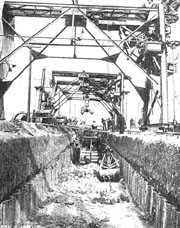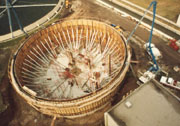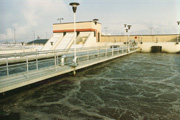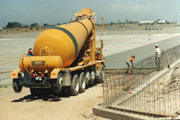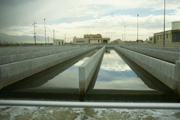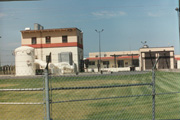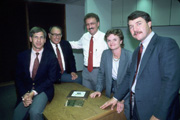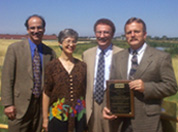Bulletin Board
Salt Lake City Wastewater Collection and Treatment Program 1889 - 2000
June 15, 2000 -- The City Council approves new rates and 6-year Capital Improvements Program, ensuring the City’s continued commitment to service and the environment
Introduction
Public sanitation is a vital element of modern society. In its simplest form, it protects public health from the transmission of disease. In modern times sanitation by the
collection and treatment of wastewater (sewage) has become the critical element of the nation's effort to abate pollution of its water. This paper describes the history of sewage
collection and treatment and the actions necessary to meet the City’s service and environmental obligations as we begin the new millennium.
On June 15, 2000 the Salt Lake City Council approved a new sewer rate structure that included charges for sewage strength greater than domestic strength waste; and a 6-year $57.5 million capital improvements program. Besides being a more equitable rate, the strength based rate structure will hopefully reduce the growing biological loading of the waste being treated at the City’s Reclamation Plant. By focusing on a true cost-of-service based on waste strength, there will be financial incentives to reduce the amount of organic material being discharged into the sanitary sewer system. The capital improvements program will construct needed system and plant improvements necessary to provide reliable operations and meet federal discharge permit limitations.See related story at: www.slcclassic.com/utilities/news05242000.htm.
The following describes the history of Salt Lake City’s sewer collection and treatment system.
Conduits of Civilization
According to the American Public Works association in its book entitled, History of
Public Works in the United States 1776 - 1996, "America's sewage systems have been rightly proclaimed as the Conduits of Civilization." This description denotes the
contribution that sewer systems have made to the nation's sanitation, public health and quality of life. The public health benefits of sewers and later the treatment of sewage are
immeasurable. Sickness and death were a common result of poor or no sanitation and disposal of human waste. Outbreaks of cholera and other epidemics scourged American
cities during the nineteenth century. For example, according to the Public Works publications, "...cholera and typhoid killed more soldiers in the Civil War than did hostile actions."
Salt Lake City’s Sewer System
Like most American cities, Salt Lake City’s sewer system began in the business district. The first sewerline was laid in 1889 when 4,229 feet of 24-inch sewer main was constructed on Fifth South Street between the Jordan River and Third West and 4,749 feet of 20-inch sewer main on the east side of Main Street. During 1890, sewer mains were installed on First South from First West to Second East.
|
|
In 1908, the Intercepting Sewer Pumping Station, located at the southeast corner of the intersection of Eighth West and Seventh South, was operating at a capacity of 4,500 gallons per minute.
The five-mile Outlet Canal from the Gravity Sewer to the Great Salt Lake was completed on November 10, 1911. On this date the sewage of the City was turned into the canal by written agreement with the New State Gun Club. A perpetual outlet was secured in order to discontinue the flow of sewage into the Jordan River. Thus the City transported its sewage to the Great Salt Lake.
A special sewage district was created in 1911 for the southeast section of the City, including all streets not already provided with sewer mains from Fifth South to Ninth South to Fort Douglas.
By 1923 there were over 297 miles of sewer mains and practically all of the developed portions of Salt Lake City were sewered. The sewer system doubled during the next 75
years, with 600 miles of sewer lines and 30 lift stations in operation by 1998.
National Pollution Control
Population growth and increasing pollution required a national program to abate the
growing quality deterioration of the nation's water.
The Environmental Protection Agency (EPA) was formed in 1970 to administer the nation's environmental programs. The 1972 Clean Water Act established national uniform
technology-based effluent standards for industrial discharges and a permit system for all point source discharges. As a result, today nearly two-thirds of the nation's waters are
swimmable and fishable, compared to only one-third in 1972. Utah passed its own water pollution control act in 1952. It then fell under the new federal act 20 years later.
Salt Lake City's Water Reclamation Plant
On September 30, 1963 a ground breaking ceremony was held for Salt Lake City's new Sewage Treatment Plant (Reclamation Plant). Supported by the League of Women
Voters, Chamber of Commerce, Kiwanis, Rotary and other service clubs and health authorities, and approved by the City's taxpayers, the City initiated a $19 million Capital
Improvements Program, that included $7 million for a new sewage treatment facility. The announcement stated, "Upon completion some 460 working days hence, the plant will
enable the City to abandon its present primitive and - to many - offensive system of discharging some 32 million gallons per day of raw sewage daily via a nine-mile open canal into the Great Salt Lake."
Completed in 1965, at a cost of over $9 million the 45-million gallon per day secondary treatment facility went on-line.
Sewage Collection and Treatment Made an Enterprise Funded Utility
In 1979, the Sewer Collection and Reclamation Division was transferred to the Department of Public Utilities and made an enterprise funded utility. As part of a 201
Facilities Plan adopted by the City Council on December 7, 1982, the treatment plant was upgraded and new unit processes added to improve treatment efficiencies.
Addressing the Problems
In 1979, the Reclamation Plant was experiencing operating problems, including odor episodes that caused the local neighborhood to demand that the problems be corrected.
These problems had been building for many years and the City Commission decided in late 1978 to transfer the Sewer Department to the Water Department to form the Public Utilities Department.
In response to the City's Commission's mandate to solve the wastewater treatment problems, on August 7, 1979, the Public Utilities Department hired a consulting firm to
conduct an odor study and to recommend an odor mitigation program. The Department implemented the consultant's recommendations to abate odor sources at the facility.
Moreover, the study concluded that major improvements would be necessary to permanently address the problems. At that time, the plant was operating at 90 percent of
design hydraulic capacity, had inadequate solids handling facilities, the digesters were partially filled with grit and much of the plant's equipment was in need of repair or
replacement. Most seriously, it was in violation of its NPDES permit.
Between 1980 and 1983, the Department spent over $2 million to correct the most serious problems.
201 Wastewater Facilities Plan
On April 1, 1981, the City contracted with an engineering firm to conduct the 201 Wastewater Facilities Study. The study was conducted in compliance with EPA
guidelines in case future EPA funds became available, and to assure that the state of Utah and Federal regulating agencies were in agreement with the City's plan and its compliance efforts.
City Seeks Federal Funds
While the 201 study was being conducted, the City attempted to gain federal funds under the Clean Water Act Construction Grants program. However, from the beginning it was
obvious that these funds would not be available and that the City would have to finance its own program. The State of Utah's federal allocation of funds was already committed
to the construction of the South and Central Valley treatment plants.
Approved 201 Wastewater Facilities Plan
On December 7, 1982 the Salt Lake City Council formally adopted the final facilities plan, and on April 5, 1984 EPA accepted the plan with a "Finding of No Significant
Impact/Environmental Assessment Report."
The 201 Plan as adopted by the City Council included a financial plan that would fund the construction of facilities on a cash flow pay-as-you-go basis. Sewer user charges
were increased from $0.54 to $1.08 per 100 cubic feet of water discharged into the sanitary sewer system, increasing the average residential sewer bill from $4.32 to $8.64
per month. Connection fees were increased from $300 per residential equivalent to $1,000 over a 3 year period. These funds would completely finance the 201 Plan on a cash flow basis.
The cash flow plan saved millions of dollars in debt service and provided maximum flexibility in making future decisions. This flexibility allowed the City to reduce sewer rates on January 1, 1986, July 1, 1988 and July 1, 1989.
Near Term Improvements
|
|
201 Facilities Plan Elements
The plan consisted of the following elements:
1. Upgrade and expand the existing 45 mgd plant to 56 mgd.
|
|
3. Construct a sewage pump station and transfer line from the existing plant to the proposed new facility in the Northwest Quadrant. (This would be postponed until needed.)
4. Purchase property site for a second treatment facility.
5. Construct emergency power/energy recovery facilities.
6. Construct administration building and renovate laboratory.
|
|
8. Discontinue service to Chesterfield Improvement District.
9. Replace Redwood Road sewer trunkline.
10.Continue televising sewer line inspections and sewer sealing.
11.Remove storm drain connections from the sanitary sewer system.
|
|
The capital costs to implement the selected plan through the year 2005 were estimated at $137 million.
201 Plan Implementation
This phase of the plan cost a total of $24.8 million and included various studies and treatment plant construction projects.
The solids handling plan was adopted on December 5, 1983 and called for sludge application to the Hinkley farmland leased from the airport. A permit to apply the sludge was granted by the City County Health Department upon completing comprehensive sludge, soil and plant tissue analyses.
|
|
Construction on the existing plant began on March 26, 1985. Plant improvements included the pretreatment plant rehabilitation, main plant rehabilitation, Administration and Laboratory building construction, short term aeration facilities and sludge management and storage facilities. The total cost amounted to $22.0 million.
Decreasing Sewer Rates
The original 201 Plan improvements were essentially completed by the fall of 1989. The work performed was done in accordance with the plan and cost less than the original estimated cost. Each year the Public Utilities Advisory Committee reviewed the Departments budget and made recommendations to the Mayor and City Council on projects and expenditures .
Because of conservation and successful inflow mitigation, the second treatment plant was postponed until conditions warrant its construction. The polished secondary standard
requirement was eliminated by the State Legislature. These changes, allowed sewer rates to be decreased. In 1986, the sewer rates were reduced by 17 percent, followed by 6
percent decreases in 1988 and 1989, totalling 29 percent in decreases.
Performance Results
|
|
Other than two years in which airport deicing waste overwhelmed the treatment treatment facility, the Reclamation Plant has had extraordinary performance without odor complaints.
|
|
On May 24, 1999 at AMSA's 29th Annual Meeting held in Washington D.C., thirteen member agency facilities, including Salt Lake City's waste water treatment facility were awarded the 1998 Platinum Peak Performance Award. To be eligible, the facilities had to earn five Gold Awards from 1994 - 1998.
New Challenges
Notwithstanding the recent successes, the future is becoming a concern. Dramatic increases in BOD loading and the end of a 20 year 201 Facilities Plan are drawing attention to Salt Lake City's future wastewater treatment needs. Monthly average TBOD loadings are reaching as high as 80,000 lbs./day, an increase of 45 percent since 1994. Increases in biological treatment capacity made during 1993 through 1996, raised the plant's capacity from 60,000 lbs./day to 96,000 lbs./day. This increase in capacity has allowed the plant to stay ahead of the loading increases, but the next increment of new capacity will require major process changes, or an earlier start on a new treatment facility near the airport.
In 1997 an engineering firm completed a Wastewater Master Plan to determine the sewage collection and treatment needs for the next 25 years. The plan calls for capital expenditures amounting to $130 million over the planning period with $57.5 million during the next 6-years.
On June 15, 2000 the City Council approved the funding for a 6-year capital improvements program. Included are improvements to the wastewater treatment plant, replacement of 20,000 feet of sewer mains each year and new trunklines.
Questions regarding this article can be e-mailed to: leroy.hooton@ci.slc.ut.us

